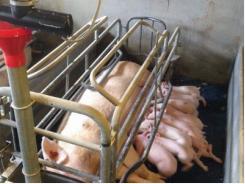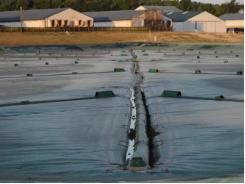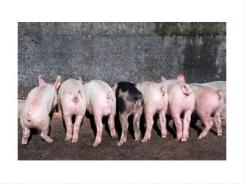Major pig diseases in China

Experts in the industry suggest that perhaps 80 percent of pig farms in China have some form of chronic classical swine fever. | twixx, BigStockPhoto.com
China is no different than other pig-producing areas; it is affected by well-known diseases that reduce productivity and profitability.
China leads the world in pork consumption and pork production with more than half of the world's pigs. The China pig industry continues to grow, consolidate and modernize, yet productivity lags behind that attained by other modernizing countries. Of course, infectious disease is only one cause of suboptimal productivity, and swine diseases have multiple causative factors that contribute to the outcome. Diseases often occur together in complex combinations, but we can still individually characterize the diseases of swine in China, which is useful for analysis, planning, training, implementing action and regaining control.
Classical swine fever
The severe acute form of classical swine fever (CSF), or hog cholera, is mostly prevented by vaccination in China, but chronic endemic CSF causes huge economic losses. Experts in the industry suggest that perhaps 80 percent of pig farms in China have some form of chronic CSF, which makes eradication by “stamping out” impossible. Chronic CSF can present as piglet diarrhea and poor growth, which is easily confused with the porcine epidemic diarrhea virus (PED virus).
CSF immunity can become destabilized by various factors, such as mycotoxicosis and porcine reproductive and respiratory syndrome virus (PRRS), resulting in flare-ups of abortion and infertility, weak pigs at birth, severe diarrhea, CNS signs (trembling, incoordination, backwards-walking, convulsions) and mortality. Post-weaning, one may see fever above 40C, pneumonia, diarrhea, central nervous system signs, blue discoloration (cyanosis) of the ears and legs, poor growth and mortality exceeding 20 percent. In grow-finish, chronic CSF pigs often succumb to diarrhea and pneumonia. Typical CSF lesions are hemorrhages on the kidneys and other organs, and ulceration of the colon, but in some cases there are no visible gross lesions.
Histopathology and molecular methods like polymerase chain reaction (PCR) aid the diagnosis. Endemic CSF spreads to piglets via persistent infected (PI) carrier sows (vertical transmission). Vertically infected pigs pass the virus to other pigs by direct contact (horizontal transmission). There has been much emphasis on serologic testing of CSF antibody levels, but such efforts are not successful in attaining CSF control. Accelerated vaccination programs can provide some short term relief from CSF, but long term control requires testing and removal of PI carriers from the breeding herds. The industry needs better vaccines updated to current field strains and more cost efficient practical molecular or immunochemical tests to detect the PI animal and screen incoming replacements.
Pseudorabies
Pseudorabies (PRV) is endemic in much of China but is generally less troublesome than CSF. Vaccination was a useful tool in those countries that have eliminated PRV, but vaccination alone will not eliminate this disease. The acute forms of PRV can look much like CSF, and indeed CSF is often misdiagnosed as PRV. Acute PRV with abortion, mummification and high perinatal mortality is seldom seen. Far more typical is the pneumonic form of PRV that occurs in growing-finishing. Control of PRV is accomplished by vaccination, sanitation, isolation and all-in/all-out management. Chinese forms of the virus differ antigenically somewhat from European strains, such that there is significant interest in developing gene-deleted Chinese-type specific vaccines for PRV.
PRRS and PCV2
At least three distinct sub-types of the North American PRRS virus trouble the Chinese pig industry. There are many antigenic variants as the virus continues to mutate and evolve itself away from the threat of herd immunity. “Classical PRRS” strains, which emerged in China in the late 1980s, are less common now than the “high-pathogenicity” form (HP-PRRS) that emerged in 2006 as “high-fever disease” [gao re bing in Chinese]. Recently, new sub-type PRRS viruses related to strain NADC30 have caused serious reproductive losses.
Acute PRRS results in abortion, mummification and high-preweaning mortality, followed by chronic respiratory disease post-wean and grow-finish complicated by secondary bacterial infection. Porcine circovirus 2 (PCV2) is a common intensifier of disease in swine and can interact strongly with PRRS, CSF and other problems, resulting in enteric and respiratory ills and wasting syndromes (porcine circovirus-associated disease, PCVAD) in the post-wean period and grow-finish. Diagnosis of PRRS can be made by histopathology and by molecular techniques such as PCR and gene sequencing. PCV2 is best diagnosed by histopathologic methods, since PCR for PCV2 might be misleading to the ubiquity of the PCV2 virus. Chinese pig producers have several choices of commercial modified live and autogenous killed PRRS vaccines, and for PCV2 there are killed and subunit vaccines, imported and domestic.
PED virus
The porcine epidemic diarrhea (PED) virus is an alphacoronavirus that is related to, but distinct from, the alphacoronavirus that causes transmissible gastroenteritis of swine (TGE), a disease with very similar characteristics. Before 2010, PED virus was known in China as an acute transient diarrhea of weaned and growing pigs. New forms of PED virus causing serious disease in suckling piglets emerged in China and Thailand in 2010. The disease is characterized by a transient diarrhea with mild fever in sows and an acute onset watery diarrhea with mortality above 50 percent in suckling piglets less than 7 days of age.
There are currently no satisfyingly effective vaccines available. Variation in the spike protein responsible for pathogenicity and antigenicity makes it somewhat difficult to make vaccines because the virus mutates rapidly in the field, and it is observed that cross protection among PED virus strains is minimal. Diagnosis is made by histopathology and PCR. Producers control the disease by feedback exposure of naive sows to the intestinal and fecal material from pigs in the early stage of the disease. Active immunization of sows is important because the acute form disease often tends to become chronic endemic where sow immunity is not high enough to eliminate the virus. PED virus, CSF and other intestinal diseases such as coccidiosis and Clostridial enteritis are often occurring concurrently so producers are well advised to get a full diagnosis of the problem before embarking on a feedback program. Since many herds were infected in 2012 and 2013, the importance of PED virus in China as a cause of huge losses has declined.
E. Wayne Johnson, DVM, is senior technical consultant at Enable Ag-Tech Consulting, Beijing
Related news
Tools

Phối trộn thức ăn chăn nuôi

Pha dung dịch thủy canh

Định mức cho tôm ăn

Phối trộn phân bón NPK

Xác định tỷ lệ tôm sống

Chuyển đổi đơn vị phân bón

Xác định công suất sục khí

Chuyển đổi đơn vị tôm

Tính diện tích nhà kính

Tính thể tích ao




 EU pig producers on high alert for African…
EU pig producers on high alert for African…  What causes secretory or nutritional diarrheas in piglets?
What causes secretory or nutritional diarrheas in piglets?